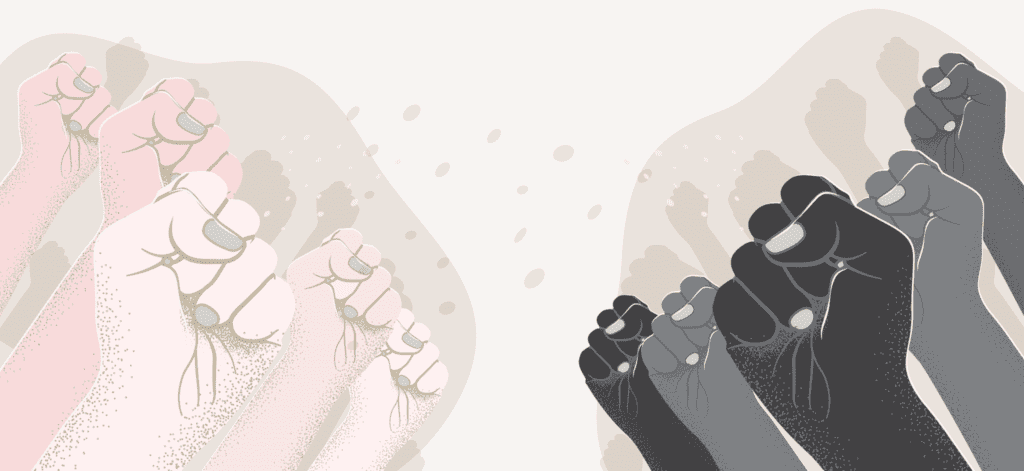Self-Advocacy or Defiance in Protests? Depends: Are You White or Black?
“Please, I can’t breathe.” Are these words of “resistance,” or are they a man’s simple plea to stay alive? In seven minutes, George Floyd became yet another Black man who…

“Please, I can’t breathe.”
Are these words of “resistance,” or are they a man’s simple plea to stay alive? In seven minutes, George Floyd became yet another Black man who has died at the hands of police. In the ensuing protests this week, consisting of mostly people of color (wearing masks to protect against COVID-19), police used tear gas to disperse the crowd clamoring for justice.
Juxtapose this with another form of protest: Pockets of angry “freedom-loving Americans” are actively protesting stay-at-home orders intended to stop the deadly spread of COVID-19. These protesters are ignoring social distancing guidelines, some carrying automatic weapons, all while threatening the health of police officers by screaming in their faces. And they’ve become increasingly more violent. Yet, not one instance of police brutality, tear gas, or death has been reported — despite breaking what counts as state law.
America is experiencing in real time two very different “protests” based on skin color. Indeed, in our country, self-advocacy is characterized as “defiance” for people of color, while defiance is characterized as “self-advocacy” for White people. Unfortunately, for many students of color, that lesson is taught early in our school system.
Consider the data from the U.S. Department of Education’s Office for Civil Rights:
These facts should universally horrify us. But, instead of shock, the response that follows — fed on hundreds of years of ingrained bias — is some version of, “Well, Black children act out more, don’t they?” As a matter of fact (and a considerable amount of data), NO. These differences exist because young, Black students in our schools are often unfairly singled out and given harsher penalties than are White students for the same or lesser offenses.
What’s more, when we look at differences in the social, emotional, and academic development of students in our P-12 space we see that far too often Black students are kicked out of classes and schools for “defiance” even when they’re justly advocating for themselves, but White students are allowed or even praised for the same behaviors. These actions send the message to all students — students of color and White students — that students of color should not advocate for themselves, and when they do, they should be put in their place. And these attitudes continue into adulthood. (See: Christian Cooper in Central Park incident.)
The truth is that while the headlines and horrendous videos have brought injustice into blunt clarity, Black lives are not only routinely threatened, undervalued, and feared by institutions that are charged to protect and serve when Black people speak out; they are threatened, undervalued, and feared across all of our public institutions, including in the very places those lives are supposed to be nurtured and grown: their schools.
This needs to stop. According to civil rights leader, Martin Luther King Jr., the goal of education is about defiance and the ability to think intensively and critically. In 1963, James Baldwin echoed Martin Luther King. Jr. in his address, “A Talk to Teachers,” when he discussed sociopolitical consciousness — the ability to critically analyze the political, economic, and social forces shaping society and one’s status in it. He stated the dispositions embedded in sociopolitical consciousness — critique, questioning, and resistance — stand in opposition to dispositions of U.S. schooling, which try to acculturate Black students by enforcing obedience, passivity, and subordination.
These Black icons knew that self-advocacy for Black students would be critical because society did not (and still does not) treat Black people as equals. Punishing political awareness, particularly when connected to one’s racial identity, undermines the very core of education. Research has shown that being an advocate or recognizing sociopolitical forces are not only paramount for identity development but also can foster academic engagement, increased academic achievement, enrollment in higher education, and civic and political engagement.
Students of color are more likely to need to learn to self-advocate, given they are more likely to experience negative bias, stereotyping, lower expectations, and discrimination, both in and out of school. They need to be able to tell adults, especially White adults, that they are in fact worthy, they are in fact capable, and that they can in fact achieve and thrive. They’ll also need to be able to tell White adults that their lives matter, and they will need White people to listen.
Schools have always mirrored society, but schools are also places where we can ignite change for society. Let’s start by sending a different message — one that says students of color can and should advocate for themselves, and that they shouldn’t be punished for it. Maybe in a generation or two, this mindset will have grown up with the generations leading the country, and we won’t see this play out in deadly ways for people of color.
Nancy Duchesneau is a P-12 policy analyst and researcher at Ed Trust.
Ashley Griffin is vice president of policy, evaluation, and research at the Black Teacher Collaborative. She is the former director of P-12 research at Ed Trust.